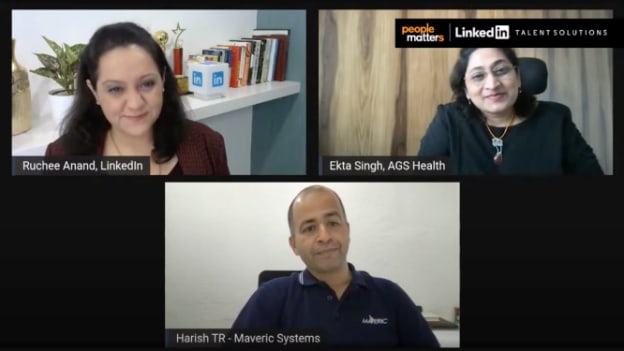HR Roadmap for 2022 - Strategy, technology and impact
One HR Read similar articles

“Company culture is having a watershed moment, and it is being reshaped in a crucible fired by the pandemic, the acceleration of automation, the rise of millennials and Gen Z, and the great resignation or the great reshuffle,” said Ruchee Anand, Senior Director - Talent and Learning Solutions, LinkedIn, opening the panel discussion on the HR Roadmap for 2022 - Strategy, technology and impact.
The panel, a partnership between LinkedIn and People Matters, featured leaders including Harish TR, CHRO & Sr VP Human Resources, Maveric System Ltd. and Ekta Singh, CHRO, ASG Health.
Recounting some of the top trends from the LinkedIn Global Talent Trends 2022 report “The Reinvention of Company Culture”, Ruchee noted some key data points that are changing the way organisations are thinking about the world of work: 67 per cent of the job seekers in India noted that good work-life balance trumps bank balance, while 57 per cent noted that compensation and benefits were a top priority.
“Employees are not just rethinking just how they work but also why,” Ruchee noted. It’s led to a scenario when “everyone is rethinking everything,” she added, quoting LinkedIn’s CEO Ryan Roslanksy. But forward-thinking organizations are working with employees to make 'home' the ‘office away from office’ to help attract, retain and grow their talent to bring about sustained talent. Here are some of the key takeaways from the conversation.
The rise of flexibility
Time and again, flexibility has been at the heart of the conversation on work, and while some employees and roles have been more conducive to operating remotely, some others have not. “Some professionals have been rock star performers in the office environment but they aren’t anymore,” Ekta noted, “What are the factors that are driving success in a remote setup?” Organisations have begun having conversations about which roles are best suited to be done from the office and which roles can rely on greater flexibility.
LinkedIn’s Global Talent Trends 2022 report shows that when employees are satisfied with their companies’ time and location flexibility, they are 2.6x more likely to report being happy and 2.1x more likely to recommend working at the company.
Extended remote work has also not necessarily been smooth, Harish noted that while it's now possible for all functions of HR to operate remotely, what’s missing is a sense of belonging and affiliation. “The sense of ‘belonging’, which is crucial to workplace experience, is very different in a remote setting than in an in-person setting,” that’s also because employees have to engage in extended communication loops and work long hours, which has invariably also led to several mental health-related concerns.
Emotional intelligence and Manager capability
Managers have been at the heart of delivering a great employee experience in the era of remote work. “For all organizations, manager capability was put to the test,” Harish noted. “Does the immediate supervisor have an empathetic view of the employee? Are they able to be adaptable to the individual and family needs? And how are they able to manage deliverables and set clear expectations during these testing periods?”
Ekta noted that the pandemic gave a real opportunity to align new learning and development programs to first-line managers. For a long time, managers have been trained on many different skill sets including communication-related training on how to have difficult conversations, how to give performance feedback, goal setting etc., but there was an opportunity, with the pandemic, to train them on how to have an emotionally intelligent conversation. And even a simple question such as “how are you?” and listening intently could greatly improve the workplace experience.
Tackling the great resignation and reshuffle
Throughout the pandemic, there’s been a slew of resignations. Ekta attributed this to the quality of employee experience. She also observed that when organisations were inflexible and mandated employees to come to the office, there tended to be a spike in resignations. The observations were consistent with LinkedIn’s Global Talent Trends Report 2022 study, according to which, “Culture can be a selling point for picky job seekers.” Data from LinkedIn users showed that there was a 2x increase in the job posts viewed per application in 2021 compared to 2019.
A study by McKinsey noted the gendered nature of the resignation. For women between 20s to 40, pre-pandemic attrition in 2019 stood at 17 per cent of the workforce and post-pandemic, that number has grown to over 23 per cent. “Women are bearing the burden of work at home and workplaces are losing talented workforce,” Ekta noted. Companies must ensure they are looking at DNI priorities, and they need to do what works for them, there isn’t any 'one-size-fits-all' approach to the problem.
Skills-based hiring and learning
Even as the great reshuffle weaned companies of talented employees, skilling emerged as a top priority for multiple industries. At Maveric, Harish noted that the company engages in a hire and nurture program that emphasizes tackling the challenge at the curriculum level by engaging in partnerships with universities and academic institutions as well as identifying skill adjacencies that help the candidate also pick up related skills.
The company also emphasizes the first 90 days of a candidate to clearly outline the expectations and also to energize candidates with the “why” and how of learning that’s mapped to their careers and future opportunities. This career path visualization not only helps engage the candidate but also helps them approach their work with greater purpose.
“The younger generation wants learning to be personalized to their needs,” Ekta noted. They also want learning to be engaging and fun to do, that’s where tools like micro-learning have become very important,”
“LXPs are going to play a key role in bringing together a great learning experience, not just to enable microlearning, but also to ensure that there is enough information about trending courses and skills that give insights to learners to nudge them to learn more effectively,” Ruchee noted.
The changing role of HR
As companies navigate new business priorities, it's going to be important for them to accept new ways of working. Harish noted that companies can no longer stick to traditional ways of working, hiring and engaging employees. If gig workers are bringing with them the expertise and time needed for different projects, organizations need to ensure there is flexibility to do that. He also pointed out the need to think beyond just traditional sources of talent in tier 1 and tier 2 cities.
Lastly, it will be critical for HR professionals to reinvent themselves as technology becomes very central to the way work is managed and executed, both within the function and throughout the employee lifecycle. Harish also noted future HR professionals need to be comfortable with speaking the language of business - and that is through data and numbers.






